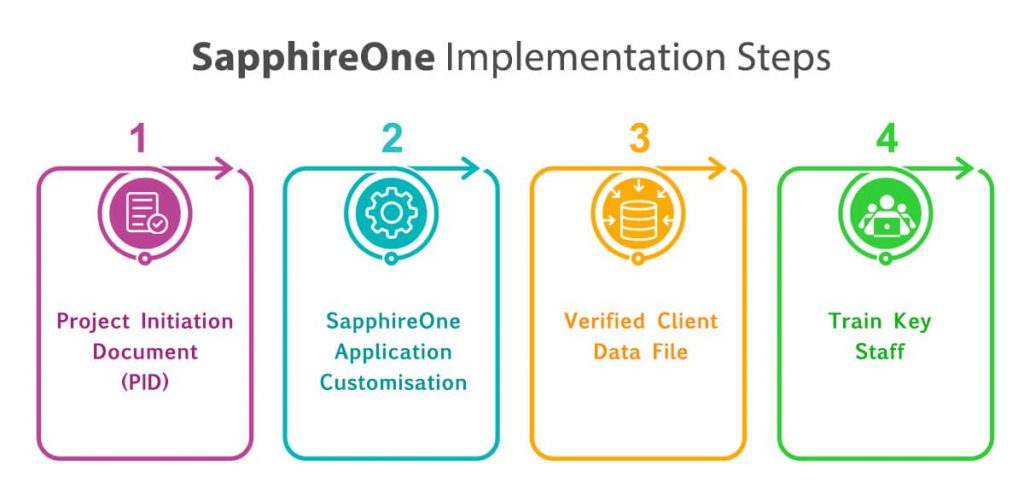4 Steps to Implement SapphireOne as your ERP System
February 19, 2020 9:38 am | by John Adams

Since our inception in 1986, we have implemented SapphireOne globally. Our sole goal is to get your organisation up and running as smoothly and as quickly as possible.
SapphireOne ERP System implementation strategy focuses on four main products
These are –
1. Project Initiation Document (PID)
2. SapphireOne Application Customisation
3. Verified Client Data File
4. Train Key Staff
1. Project Initiation Document (PID)
PID defines the project in order to form a basis for its management and assessment of its overall success. The document outlines the objectives and desired outcomes, project scope (including customisation requirements) and exclusions, project costs, project plan, project controls and the roles and responsibilities of the project team.
The PID contains 9 activities.
- Team Viewer Scoping sessions
Demonstrate current business processes using SapphireOne and identify gaps - Customisation Designs
Develop designs for customisations from gap analysis - Data Integrity Assessment
Assess current data for anomalies and rectify any out-of- balance accounts - Business Case
Document the objectives and expected outcomes for the project - Project Scope
Document project scope in its entirety - Identified Project Team
Identify & assign team members and management structure - Role Descriptions
Refine role descriptions and responsibilities - Project Plan
Document how and when the project’s objectives are to be achieved - Project Contols
Identify stage boundaries, monitoring and reporting requirements
2. SapphireOne Application Customisation
This is a version of the SapphireOne Application that includes any identified and agreed to product customisations. In these steps SapphireOne programmers develop customised functionality based on the approved customisation designs which when completed forms part of our generic source code.
3. Verified Client Data File
This is an electronic file generated by the SapphireOne Application and linked to the Client’s own unique identifier.
The file includes all imported data and formatting as dictated by First Time mode and is located on the Client’s dedicated SapphireOne server. This file has undergone testing for any identifiable data anomalies by the SapphireOne Team and the Senior User.
There are 3 core components in the verified client data file steps.
- Data Migration
At first, our implementation team Imports base data , Import balances , Import client and vendor specific data, inventory data, job project data, Payroll/HR data, Asset data, CRM data etc and reconcile balances. This is a lock down period in the implementation steps process. - Configuration
After that, we configure clients, vendors, General Ledger Accounts, contacts details, payroll/HR sections, assets, inventory, job projects and other additional clients requirements. At the end of these steps we tailor the outputs and are ready for a Go Live. - Verification & Adjustment
After going live, we conduct live verification and data adjustments.
4. Train Key Client Staff
Identified Key Users as designated by the Senior User, acknowledge that they are comfortable with their ability to use SapphireOne to accomplish their assigned tasks after undergoing Team Viewer training sessions, self paced learning using the Sapphire Single User and Bondi Blue training tool and the Data Re-key exercise.
There are 3 activities in the training steps.
-
Team Viewer Training Sessions
Our support team conducts One-on-one Team Viewer training sessions - Re Keyed Data
In this step, users re-key data accumulated from date of lock down - Task Confidence Assessment
Finally, senior users review the whole system and upon confirmation of the completion of the 4 steps SapphireOne implementation, it is then complete.
We pride ourselves on supporting our clients’ businesses as they grow from a venture to a major global enterprises; and as SapphireOne is highly scalable, with the ability to support 1000s of users concurrently, we readily adapt to meet the changing requirements brought on by your business expansion.
SapphireOne Project Initiation Document (PID) and High Level Project Plan
January 12, 2018 11:04 am | by John Adams

In order to define the scope of a project, it is necessary to first determine the project objectives. The objective of a project may be to produce a new product, create a new service to provide within the organisation, or develop new software. There are any number of objectives that could be central to a given project. It is helpful to formulate and define the scope statement before undertaking a project. We suggest you look at some examples and find out what works and what doesn’t work when creating your own scope document.
SapphireOne Project Initiation Document and High Level Project Plan below :-
Project Initiation Document
The Project Initiation Document (PID) is one of the most important objects in project management because it provides a base for the project. It specifies why the project is important, what will be delivered, when it will be delivered and how. It’s the contract between the project management team and the navigating committee, or sponsor, if you like. A comprehensive project plan is a key document that binds you, your project team, the project sponsor and the beneficiary. It is an agreement that defines the work of the project and the beneficiary’s project/programme purpose objectives. A comprehensive plan can help you identify changes in scope after the project has started and help you plan for any modifications or adjustments that might be needed during the life cycle of the project.
Document Control
Clear cut document control procedures ensure a better flow of information, which in turn ensures smoother operations and timely work. Document control procedures are an integral part of project management.
SapphireOne Project Document Control is the most comprehensive system available for creating, managing and tracking documents across all your projects. In the absence of clearly established policies and procedures for document control, several problems can arise ranging from ordinary confusion to serious financial losses. SapphireOne will provide you with some tips on how to introduce the best document control procedures for a project that do not obstruct the flow of information, and yet ensure the flow of documents are well measured. It is important to understand these procedures should not be complex, since complexity will cause people to avoid using documents.
Roles and responsibilities of the Project team
Project team organisation is one of the basic and most essential activities within the project management process. The SapphireOne Team performs the tasks that have been allocated, keeping the project manager informed of progress as well as any issues that may arise. The project team are responsible for completing the project. The role often requires team members to work on their own initiative in areas where they are the ‘professionals’. Successful projects are usually the result of careful planning and the talent and collaboration of a project’s team members. Projects can not move forward without each of its key team members, but it’s not always clear who those members are, or what roles they play. The Project Team, under the direction of the Project Manager, is responsible for carrying out the work detailed in the project plan.
Project Plan
This plan provides a statement of how and when the Project’s time, cost, scope and quality performance targets will be achieved by identifying the major products, activities and resources required for the project. It will provide a baseline against which to monitor the project’s progress stage by stage. Behind every successful project is a firm, thorough project plan. The SapphireOne plan defines every aspect of your project. The final product is utilised as a clear direction on the project for all the project investors. The scope statement is arguably the most important document in the project plan.
The scope statement includes an understanding of the business needs, current limitations, what is expected from SapphireOne and the project objectives. Key milestones and dates state at which point deliverables will be included and excluded, the approach taken, and includes other components dictated by the size and nature of the project.
Risk
All projects are exposed to risks that may affect either the project’s estimated time frame, scope or cost. To reduce the possibility of risk occurrence, SapphireOne have developed a Risk Management Plan which identifies potential risks that may affect the project’s outcomes and risk responses, at the project planning stage.
A Risk Register will be maintained throughout the project, SapphireOne continuously monitors risks and will inform all project stakeholders of any risks or issues as they arise and advise on the best course of action. Conducting a risk audit is an essential component of developing an SapphireOne application.
For a sneak peek at the full capabilities of an ERP, CRM, Accounting Software check out SapphireOne and request a live demo, its everything you’d ever need to make management a breeze.
